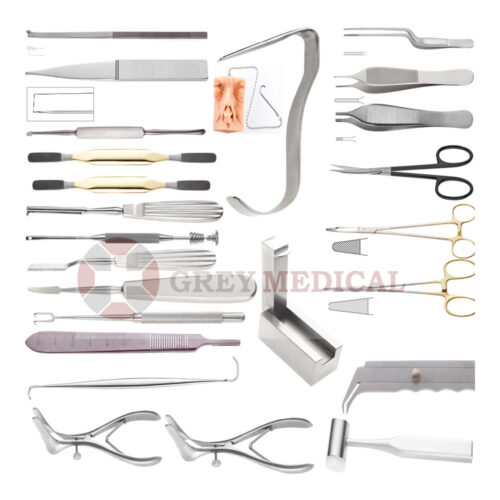Gruber Plastic Surgery Instruments: Precision Tools for Delicate Procedures
Gruber Plastic Surgery Instruments: Precision Tools for Delicate Procedures
Blog Article
Gruber instruments are specialized surgical tools commonly used in plastic surgery and reconstructive procedures. These instruments are named after or inspired by designs that facilitate precision and control, crucial for achieving optimal outcomes in surgeries where aesthetics and functionality are paramount. Known for their ergonomic designs and fine craftsmanship, Gruber instruments are staples in operating rooms for a wide range of plastic surgery applications.
Overview of Gruber Instruments
Gruber plastic surgery instruments are primarily designed for delicate tissue manipulation, precision cutting, and fine suturing. They are crafted with a focus on minimizing tissue trauma while enabling the surgeon to perform detailed work effectively. Common Gruber instruments include forceps, retractors, scissors, and specialized surgical tools tailored to plastic surgery needs.

Common Gruber Instruments in Plastic Surgery
1. Gruber Forceps
- Purpose: Designed for grasping and holding delicate tissues without causing damage, such as in facial or eyelid surgeries.
- Features:
- Fine, atraumatic tips with smooth or serrated surfaces.
- Available in straight or curved designs for versatility.
- Applications:
- Used to hold skin flaps, fine sutures, or graft materials during plastic and reconstructive procedures.
2. Gruber Scissors
- Purpose: Fine-tipped scissors for cutting delicate tissues and sutures.
- Features:
- Precision cutting edges with straight or curved blades.
- Available in various lengths for different surgical needs.
- Applications:
- Ideal for procedures like rhinoplasty, blepharoplasty (eyelid surgery), or soft tissue reconstruction.
3. Gruber Retractors
- Purpose: Used to gently hold back tissues and provide exposure to the surgical site.
- Features:
- Small, lightweight retractors with smooth edges to minimize tissue trauma.
- Designed for use in confined areas.
- Applications:
- Commonly used in facial surgeries, such as facelifts or reconstructive procedures.
4. Gruber Needle Holders
- Purpose: Precision instruments used to hold and guide needles during suturing.
- Features:
- Fine jaws with excellent grip for handling small sutures.
- Ergonomic handles for improved control during intricate suturing.
- Applications:
- Frequently used in procedures requiring delicate suturing, such as skin closures or microsurgical repairs.
5. Specialized Gruber Instruments
- Instruments like micro forceps or bone cutters under the Gruber name may be used in surgeries like rhinoplasty or craniofacial reconstruction.
Applications of Gruber Instruments in Plastic Surgery
Gruber instruments are specifically designed to meet the demands of plastic surgery, where precision and minimal trauma are critical. These instruments are commonly used in:
- Cosmetic Surgery
- Rhinoplasty (nose reshaping)
- Facelifts
- Blepharoplasty (eyelid surgery)
- Liposuction (for fine contouring)
- Abdominoplasty (tummy tuck)
- Reconstructive Surgery
- Skin grafting for burn injuries or trauma.
- Breast reconstruction post-mastectomy.
- Craniofacial reconstruction for congenital or acquired deformities.
- Microsurgery
- Procedures involving small blood vessels and nerves, such as hand surgery or digit replantation.
- Dermatological Procedures
- Removal of lesions or scars with minimal scarring.
Advantages of Gruber Instruments
- Precision:
- The fine-tipped designs allow for accurate manipulation of tissues and sutures.
- Tissue Preservation:
- Atraumatic tips and edges reduce damage to surrounding tissues, ensuring better healing and minimal scarring.
- Ergonomic Design:
- Handles and grips are crafted for surgeon comfort, reducing hand fatigue during long procedures.
- Versatility:
- Suitable for a wide range of plastic and reconstructive surgical applications.
- Durability:
- Made from high-quality surgical-grade stainless steel, Gruber instruments are resistant to corrosion and can withstand repeated sterilization.
Maintenance and Care
To maintain the performance and longevity of Gruber instruments, proper care and maintenance are essential:
- Cleaning:
- Clean instruments thoroughly after each use to remove blood, tissue, and other debris. Use ultrasonic cleaning for intricate parts.
- Inspection:
- Regularly inspect for signs of wear or damage, such as dull edges or loose hinges. Replace or repair as necessary.
- Sterilization:
- Follow recommended sterilization protocols, such as autoclaving, to ensure aseptic conditions.
- Storage:
- Store instruments in a dry, clean, and sterile environment to prevent contamination or corrosion.
Conclusion
Gruber instruments are a cornerstone of modern plastic surgery, offering precision and reliability for delicate procedures. Whether used in cosmetic enhancements or complex reconstructive surgeries, these tools enable surgeons to achieve optimal results while preserving tissue integrity and promoting faster healing. With proper care and maintenance, Gruber instruments remain valuable assets in any surgical setting, supporting the meticulous work required in plastic and reconstructive surgery. Report this page